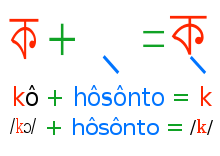This page will introduce the first twenty-five consonants of the Bengali language, namely, the স্পর্শ বর্ণ-s (Spôrsô bôrno, English translation : "Plosives" or "Stops", IPA : /spɔrsɔ bɔrnɔ/), since they are easier to learn at first. The Bengali plosives are subdivided into five classes, according to their place of articulation. The following table provides an overview of the Bengali spôrsô bôrnos.
| Consonant class (বর্গ, barga, /bɔrgɔ/) | 1st consonant (voiceless, not aspirated) | 2nd consonant (voiceless, aspirated) | 3rd consonant (voiced, not aspirated) | 4th consonant (voiced, aspirated) | 5th consonant (nasal) |
|---|---|---|---|---|---|
| ক-বর্গ (ka-barga, /kɔ bɔrgɔ/), Velars | ক /k/ | খ /kʰ/ | গ /g/ | ঘ /gʱ/ | ঙ /ŋ/ |
| চ-বর্গ (ca-barga, /t͡ʃɔ bɔrgɔ/), Palatals2 | চ /t͡ʃ/ | ছ /t͡ʃʰ/ | জ /d͡ʒ/ | ঝ /d͡ʒʱ/ | ঞ /n/1 |
| ট-বর্গ (ṭa-barga, /ʈɔ bɔrgɔ/), Retroflexes | ট /ʈ/ | ঠ /ʈʰ/ | ড /ɖ/ | ঢ /ɖʱ/ | ণ /n/1 |
| ত-বর্গ (ta-barga, /t̪ɔ bɔrgɔ/), Dentals | ত /t/ | থ /tʰ/ | দ /d/ | ধ /dʱ/ | ন /n/1 |
| প-বর্গ (pa-barga, /pɔ bɔrgɔ/), Bilabials | প /p/ | ফ /pʰ/ or /ɸ/3 | ব /b/ | ভ /bʱ/ or /β/3 | ম /m/ |
^1 ঞ, ণ and ন used to have different sounds in earlier Bengali, but in modern Bengali they all sound like the dental /n/.
^2 The palatals are not actually palatal sounds in Bengali anymore. Instead, they are more or less Affricates.
^3 ফ and ভ are usually pronounced as bilabial aspirates, /pʰ/ and /bʱ/. However, in modern Bengali, they are also pronounced as bilabial fricatives /ɸ/ and /β/.
The Hôsônto, ্

The hôsônto or hôlônto is a diacritic looking like a diagonal tick mark going from north-west to south-east direction. In Bengali, all consonants are pronounced with an inherent অ (ô, /ɔ/), so ক is actually pronounced kô (/kɔ/). Adding the hôsônto means that you are removing that অ (ô, /ɔ/). Therefore ক্ is simply /k/. It is worthwhile to mention that kô is also the name of ক. In this way all the consonants are named. An exception to this are the consonants জ and ব. These two are called বর্গীয়-জ (borgio-jô, /bɔrgiɔ ɟɔ/) and বর্গীয়-ব (borgio-bô, /bɔrgiɔ bɔ/) respectively, in order to distinguish them from য and the second ব, mentioned in Consonants, Part Two.
Aspirates
One special feature of Bengali alphabet is the presence of letters representing both aspirated and unaspirated consonants. This is in contrast to English, which only has letters for unaspirated consonants in its alphabet, Although English does have aspirated sounds. Notice the difference between pill and spill. In the former case, the p in pill is aspirated, while in spill it is not. The aspirated consonants (i.e., খ, ঘ, ছ, ঝ, ঠ, ঢ, থ, ধ, ফ, ভ) are pronounced just the same as their unaspirated counterparts ক, গ, চ, জ, ট, ড, ত, দ, প and ব except for the presence of a strong breath just after the consonant. While pronouncing খ্, it almost sounds like ক্ + হ্.
Bibliography
Bengali Alphabet - The Consonant section in Bengali Alphabet article in Wikipedia.
Aspirated Consonant - The Wikipedia page on Aspiration and aspirated consonants.